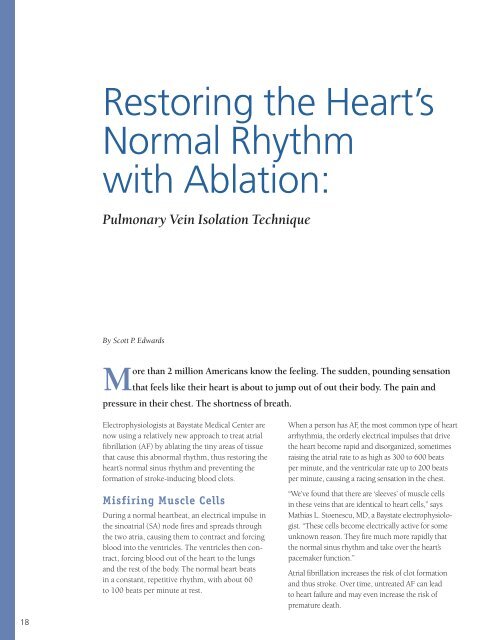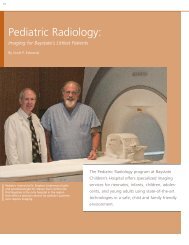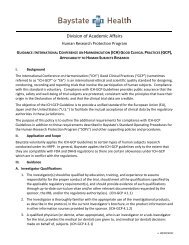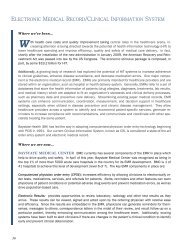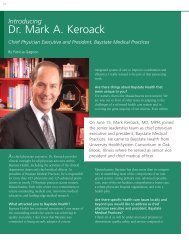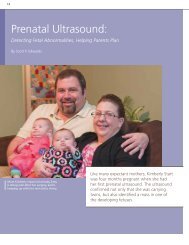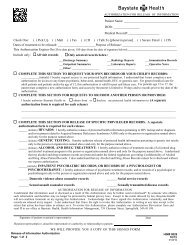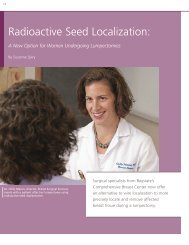Restoring the Heart's Normal Rhythm with Ablation - Baystate Health
Restoring the Heart's Normal Rhythm with Ablation - Baystate Health
Restoring the Heart's Normal Rhythm with Ablation - Baystate Health
Create successful ePaper yourself
Turn your PDF publications into a flip-book with our unique Google optimized e-Paper software.
By ablating <strong>the</strong> tiny areas of tissue that causeatrial fibrillation, electrophysiologists at <strong>Baystate</strong> canrestore <strong>the</strong> heart’s normal sinus rhythm and prevent <strong>the</strong>formation of blood clots. (Shown: Dr. James Cook,director, Cardiac Electrophysiology.)
a transseptal ca<strong>the</strong>terization. During this procedure,a needle is used to make small hole in <strong>the</strong> septumdividing <strong>the</strong> two atria. The ca<strong>the</strong>ter is <strong>the</strong>n threadedfrom one atrium to <strong>the</strong> o<strong>the</strong>r. After <strong>the</strong> procedure,<strong>the</strong> hole closes on its own.“Access from <strong>the</strong> right atrium to <strong>the</strong> left is moredifficult and takes longer,” says Dr. Stoenescu. “Also,trying to isolate <strong>the</strong> pulmonary veins by going in apoint-to-point fashion so <strong>the</strong> electrical current can’tslip through is tedious work.”The average PVI procedure takes four to five hoursto complete compared to o<strong>the</strong>r ablation procedures,which typically take less than two hours.Outcomes and RisksPVI is most effective in <strong>the</strong> initial stages of atrialfibrillation — paroxysmal AF — during which <strong>the</strong>heart beats in a normal rhythm <strong>with</strong> occasionalepisodes of arrhythmia. Dr. Fox says patients <strong>with</strong>paroxysmal AF respond well to <strong>the</strong> procedure, <strong>with</strong>a 70 to 80 percent success rate.The procedure’s effectiveness goes down in cases ofpersistent AF, when <strong>the</strong> arrhythmia is usually present<strong>with</strong> infrequent, short-lived episodes of normal sinusrhythm, and in permanent AF, in which patients arealmost always in atrial fibrillation. “In <strong>the</strong> latter twostages of AF,” says Dr. Stoenescu, “<strong>the</strong> success ratedrops to around 60 percent.”While PVI is effective at stopping atrial fibrillation,it is not <strong>with</strong>out risk. As <strong>with</strong> any ca<strong>the</strong>terization,<strong>the</strong>re is a slight risk of damaging blood vessels when<strong>the</strong> ca<strong>the</strong>ter is inserted and directed toward <strong>the</strong> heart.Ablating in or near <strong>the</strong> pulmonary veins can, in somecases, lead to stenosis and reduced blood flow to <strong>the</strong>heart. In addition, cauterizing <strong>the</strong> tissue can increase<strong>the</strong> risk of blood clots, which if dislodged, can leadto stroke.Pulmonary vein isolation isincreasingly being used to treatAF, <strong>with</strong> excellent results.Perhaps <strong>the</strong> most serious complication of PVI isatrial-esophageal fistula between <strong>the</strong> left atrium and<strong>the</strong> adjacent esophagus caused by <strong>the</strong> RF energy usedto ablate abnormal tissue. Dr. Fox says that whileatrial-esophageal fistula is a “dangerous” complication,it is rare, occurring in less than one percent of patients.The biggest challenge doctors face in controllingatrial fibrillation is learning more about <strong>the</strong> condition.“<strong>Ablation</strong> for o<strong>the</strong>r forms of arrhythmia has a 90 to100 percent success rate,” says Dr. Fox, “because weknow more about and understand <strong>the</strong>se types ofarrhythmias and how to get rid of <strong>the</strong>m. We’re stilllearning about AF and how it responds to ablation.”For more informationor to refer a patient, call 413-794-7246.21


